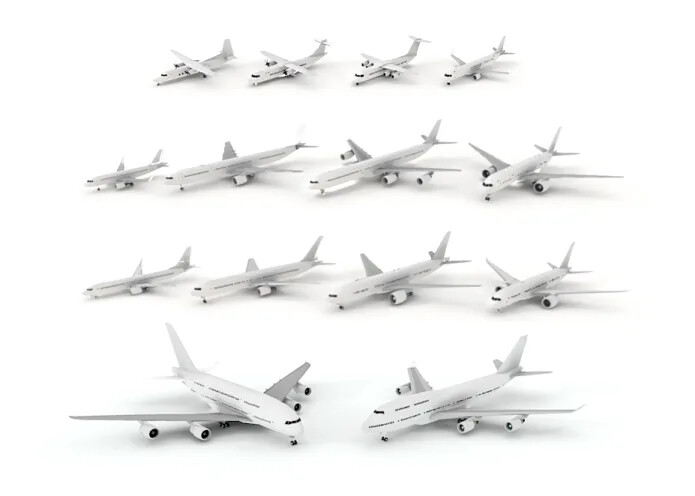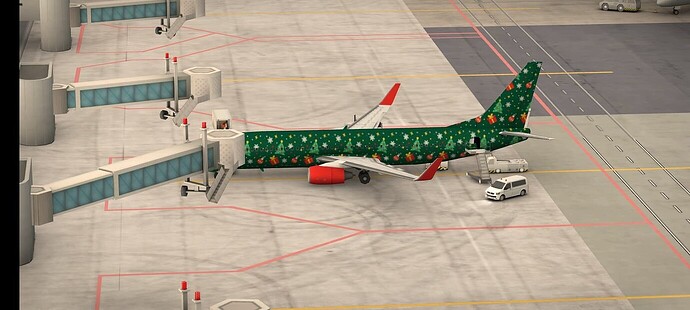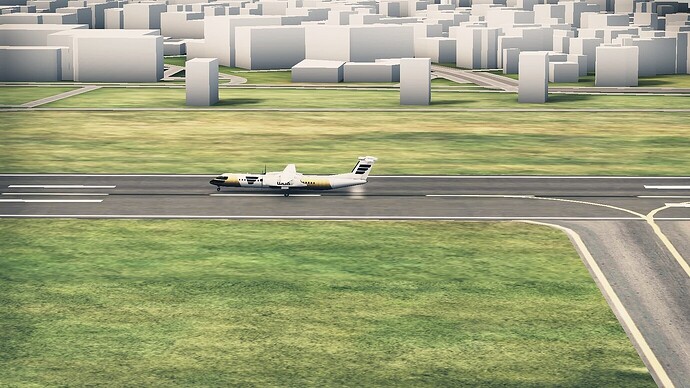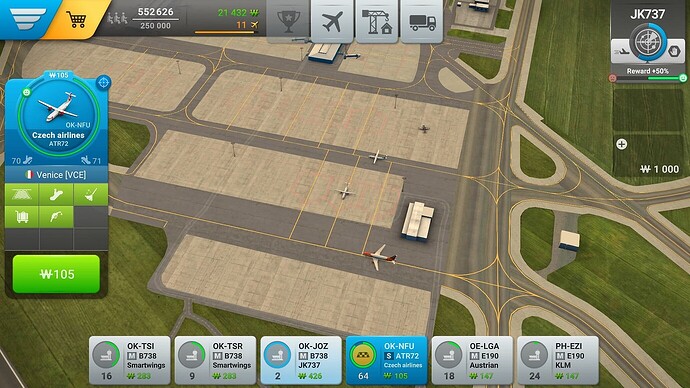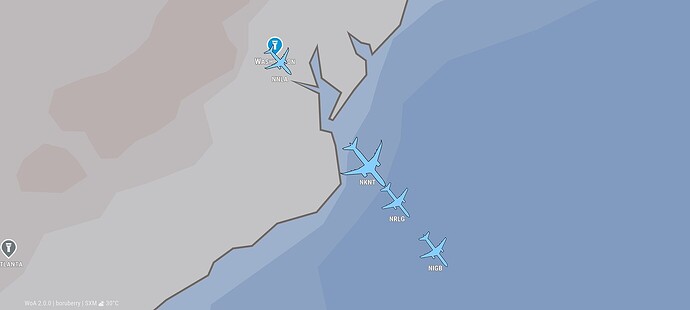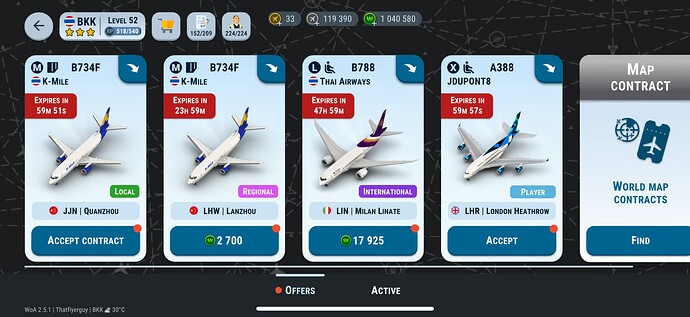WoA: A History
Post created by @Thatflyerguy
Current as of WoA 3.0.4
World of Airports is one of the most community-driven games I have ever seen, and it is also one of those that I have sunk the most time into. Over the thousands of hours, I have watched the game evolve from its earliest state into something truly special, had the honor of joining the Orion Alliance, and engaged with so many great people. This game is one of the greatest I have ever played, and it has therefore been really interesting to discover more about its history. I hope you enjoy reading this as much as I enjoyed writing it.
-Thatflyerguy
Contents
Early Days
Update Cycle/History
1.0, 2.0, and 3.0 - The Major Versions
1.0
2.0
3.0
Developers
On October 22, 2019, Flyboys games, a small studio based out of Prague in the Czech Republic, released World of Airports. Flyboys was a tiny group of 7 friends, all really into commercial aviation, working in their spare time to develop the game. They had been working together since at least 2017, when they released Airport PRG. That game blew up, amassing over 600,000 downloads by mid-2018. It was generally well reviewed, but there were some major flaws, and Flyboys wanted to release a new game, rather than simply patching PRG.
In July of 2018, having put a lot of work into what would become World of Airports, the team released a crowdfunding request on IndieGoGo, which raised around $2100 US Dollars. This was far short of their goal, but it was enough to enable work to go forward, and so it did. Just a few weeks later, they had put a lot of the models and animations together, and were aiming to begin alpha testing by the end of the year. An early timeline for if they achieved their $100,000 USD goal had the game releasing in the 1st quarter of 2019, however they fell far short of that.
An early timeline from ~May 2018
Around the same time, the team released a series of trailers. These show the game in a primitive state of graphics, lacking most textures, but reasonably functional. At this point, the game was slated to have three airports on release (INN, BRI, and PRG), and 14 aircraft models (of which only 12 are in game even today and only 6 released on time (alongside two that weren’t mentioned, the Bae 146 and Concorde)).
Although they did not meet release goals, Alpha testing still began in early summer of 2019. They stretched for around 2 months, before coming to a conclusion to pave the way for the start of beta testing right around the end of august. As early as July, though, Shill, a developer, posted the release date on the forum. The predictions would be correct, and on October 22, 2019, it was released to the public on iOS and Google Play.
An initial estimate of which aircraft would arrive in-game. Notably, it includes the F-27, RJ-85, and 767.
Early on in the game’s history, updates came nearly weekly, with the game receiving an astonishing amount of new content given the short timeframe. In the first two months alone, at least 12 and possibly as many as 14 updates were pushed out, bringing major new features like leaderboards, three new aircraft, IAD airport, and much, much more. This pace would carry on into the new year, and the year after that, but by mid-2021, with the developers now focusing more on quality and less on quantity, the pace had slowed considerably. Over the next year, updates came out at a pace similar to that of current releases, before cutting out entirely. The last major update took place in December of 2021, and a handful of minor updates dragged on into early 2022. In May, 1.50.5 released, bringing only the fighter jet easter egg at SAN. It would be over a year before the next update.
The developers, however, had not been idle during these months, and as early as February 2022, there were hints of a complete game overhaul in the air. By April, it was common knowledge that one was in progress. Commenters on the forum were generally of the opinion that it would be soon, noting that the pace of updates had fallen off dramatically but that it seemed something big was in the works. In early April, possibly for an April fools surprise, loading screens briefly had WoA 2 on them instead of simply WoA. However, the update was not just around the corner, not even close. Those four months turned into 8. Then 12. Then 16. 2.0 was far and away the most anticipated update in WoA history, and for good reason, because there was nothing else happening. Developer communication was also extremely spotty during this period, and a lot of people simply lost patience and left the game, believing nothing more was to come.
However, the dark days did not last forever, and after a massive wait of almost 18 months, version 2.0 released to the public. The update left many with long lists of gripes about what had been changed, but they would adapt over time, and for the most part it was incredibly well received. The update cycle, while never returning to the update every week or two that it had been before, still rose again to a pace of roughly monthly releases, and the devs learned from the mistakes of 2.0, never again having such poor communications with the player base. Since 2.0, the pace of updates has stayed steady at around 1 a month, with the exception of a 4-month hiatus for 3.0, which released on April Fool’s day of 2025.
1.0, 2.0, and 3.0 – The Major Versions
There have been three major versions over the last 6 years.
Version 1 was the release era, lasting from late 2019 all the way to mid-2023. It spanned dozens of updates, including 6 major ones, and is still regarded fondly by older players. Version one had two generations of aircraft over those four years, with the initial release aircraft still one of the most iconic things in WoA history. The developers at this time were not yet very experienced with 3D modelling, and the first generation of aircraft designs had hexagonal engines and fuselages. Also, basic proportions tended to be slightly off. However, in version 1.30.2 this started to change with the remodel of the 737-800, and two weeks later the release of the 737-400 and An225. These marked the first releases of second-generation models, which was a game changer. The model standard was quite accurate and benefited from far less geometric engines and all, and marked a major upgrade. Version 1.0 had other iconic features too. For example, there was a landing priority button, which enabled you to set how many takeoffs you wanted per landing, and a speedup button that increased the rate of handling in exchange for wollars. Also, after fleet aircraft reached a certain point in their lifespan, you could scrap them for Golden Planes. There were downsides to 3.0, however. It did not have a particularly organized codebase, graphics were lacking, and there were many other issues with it. In fact, the bloated code was what really led to 2.0, and what made the wait so long. Flyboys rewrote huge portions of the game from scratch, in addition to hugely boosting visuals and redesigning the gameplay.
A series of 1.x screenshots that showcase old terrain, the release-era 738 model, and the initial UI
Version 2 was the point at which the game went from looking clearly homebuilt to looking actually quite professional. Graphics were improved across the board, and the game got much faster. The update introduced a new UI and reimagined how people interact with a lot of the game. For instance, contracts were streamlined dramatically, into the current contract manager. Also, handling changed from tapping based and possible to speed up to a system of handling crew, where you assign crew and have the option of automating it for an additional crew member and some wollars. 2.0 also brought with it version 3 aircraft, beginning with the DHC6 and 744. Because the update had taken such a long time to arrive, almost 1.5 years, all players active at the time were rewarded with SXM airport for free. For the most part, 2.0 was well received, although the classic look of the game remains deeply loved by the original community.
A new 2D map showcases aircraft movements globally as part of the new UI, and the remodeled 747 stands at SXM airport.
2.0 did, however, bear with it numerous problems. Most were small, but there were some big annoyances mixed in with them, and the team decided to rectify that with version 3.0. In addition to the first South American airport and continued graphical fixes, a redesigned UI was introduced that improved on a lot of the 2.0 UI, generally making the game easier to play while also incorporating significant new features. There were also a lot of quality-of-life changes in this new interface, such as implementing a slider when adding handling crew so that you don’t have to tap as many as 20 times per aircraft. It also completely changed aircraft categorization. In all previous versions, the system used SMLX notation, but that was changed in 3.0 to reflect the ICAO system, which uses ABCDEFG. This makes taxi routing easier for the devs to work on, as the ICAO system considers wingspan in addition to weight and length, enabling more realistic ATC patterns.
While most of the code for WoA is written in-house, Flyboys still maintains major partnerships with outside developers. For example, starting with the release of LHR airport in December of 2022, they outsourced the actual modelling of the airports to TaiModels, a company that is primarily known for their DLCs for X-Plane. Tai has produced the models for LHR, GRU, SYD, BKK, and soon, SCL. It is not known, however, if the company is also producing the generic airports, or if that is the WoA devs. Another other major partnership is with Cesium, which provides the skybox for WoA.
No game is possible without a talented and passionate development team behind it, and WoA is no exception.
The World of Airports developer team began work in 2016 or early 2017 on AirportPRG, when they founded Flyboys Games. The team at this point was working only in their spare time, while still working their day jobs at a logistics/manufacturing software company called Haug-land. They had worked together before, and long been friends, even building and operating 737, Cessna, and Robinson flight simulators. Early on, there were seven members of the team, but over the years they have grown to 11, plus a cat. There are now many developers, two customer-side members (marketing/customer support), an artist, a data analyst, two aviation specialists, and more. The team remains small however, and is now based in Klastarec nad Ohri, in the Czech Republic.
WoA Dev communications with the player-base have improved dramatically over the last few years. After the lows of the year and a half long wait for 2.0 in 2022/2023, in which players went months without hearing from devs and over a year without an update, the team started to turn it around. Devblogs became much more frequent, as did forum and Instagram posts. In April 2024, Kubasan hosted Flyboys’ first devchat, which was incredibly popular and has been replicated every 5 months since. Although the dev team is still well known for delays and promised items not being delivered upon, they now do a good job of communicating with their players. Interestingly, their release strategy is to drop updates with very little warning. This likely reduces the risk that comes with potential game-breaking bugs being discovered by swarms of players playing the new update, and increases the time that players take to adopt the new updates, giving them more time to make fixes.
The dev team, while remaining small, is incredibly passionate about what they do, and also care a lot about the community. Those two attributes are what make them so good and are a large part of why this community remains so active.
Image Credits:

